The Market Dynamics of Ceramic Sand Prices An In-Depth Analysis
Ceramic sand, a critical material in a variety of industrial applications, has seen significant fluctuations in prices over the past few years. This inert and thermally stable substance is renowned for its use in the foundry industry, particularly in the production of ceramic molds and cores. It is also utilized in construction, oil and gas extraction, and as a filtering agent in water treatment processes. Understanding the dynamics of ceramic sand prices is essential for industry stakeholders, as these fluctuations can impact production costs, profitability, and overall market stability.
Understanding Ceramic Sand and Its Applications
Ceramic sand is primarily composed of kaolin, a natural clay mineral. Its unique properties, such as high refractoriness, low thermal expansion, and excellent permeability, make it an ideal choice for various applications. In the foundry industry, ceramic sand serves as a superior alternative to traditional silica sand, providing enhanced mold quality and durability. Additionally, in the oil and gas sector, ceramic proppants made from ceramic sand are used to enhance hydraulic fracturing processes, thereby improving the extraction of hydrocarbons.
Price Influencing Factors
Several factors contribute to the variability in ceramic sand prices. One of the primary drivers is the supply-demand balance. When demand from industries such as construction and energy increases, prices tend to rise. Conversely, an oversupply of ceramic sand can lead to decreased prices as manufacturers and suppliers adjust to market conditions.
Another key factor is the cost of raw materials. The global market for kaolin, which is the main component of ceramic sand, is influenced by mining costs, transportation fees, and geopolitical factors. For instance, if there are disruptions in supply due to political instability in a major kaolin-producing country, this can lead to scarcity and subsequently inflate prices.
Exchange rates also play a significant role in the international trade of ceramic sand. As many countries rely on imports for their ceramic sand needs, currency fluctuations can impact the cost of materials significantly. A stronger domestic currency can make imports cheaper, while a weaker currency can drive up costs, affecting the overall pricing structure in the market.
ceramic sand price

Technological Advancements and Their Impact
Technological advancements in extraction and processing methods have also influenced ceramic sand prices. Innovations that enhance efficiency, reduce waste, and lower energy consumption can lead to reduced production costs. Companies that adopt such technologies may offer more competitive pricing, which can shift market dynamics. Conversely, if the industry faces a technological stagnation or significant investments in new technology, short-term disruptions can impact prices due to initial high costs.
Global Market Trends
The global market for ceramic sand is projected to grow, driven by expanding industrial applications and increased infrastructure development worldwide. Regions such as Asia-Pacific, particularly China, are demonstrating robust growth due to heightened urbanization and industrialization. This growing demand is expected to exert upward pressure on prices, particularly as the balance of supply and demand shifts favoring production capabilities.
Conversely, sustainability concerns are prompting manufacturers to explore alternative materials and recycling processes that might impact ceramic sand demand. As industries move toward more sustainable practices, the demand for ceramic sand could see fluctuations, thus influencing its pricing in the long term.
Conclusion
The pricing of ceramic sand is a complex interplay of supply and demand dynamics, raw material costs, technological advancements, and global market trends. As industries continue to evolve and expand, stakeholders must remain vigilant, adapting to changing conditions that could influence pricing. Understanding these factors will enable better strategic planning and decision-making for businesses reliant on ceramic sand, mitigating risks associated with price volatility. In this dynamic landscape, staying informed and agile is key to sustaining profitability in the competitive market of ceramic sand.
Post time:paź . 12, 2024 03:53
Next:Techniques for Smoothing and Finishing 3D Printed Objects for Perfect Results
